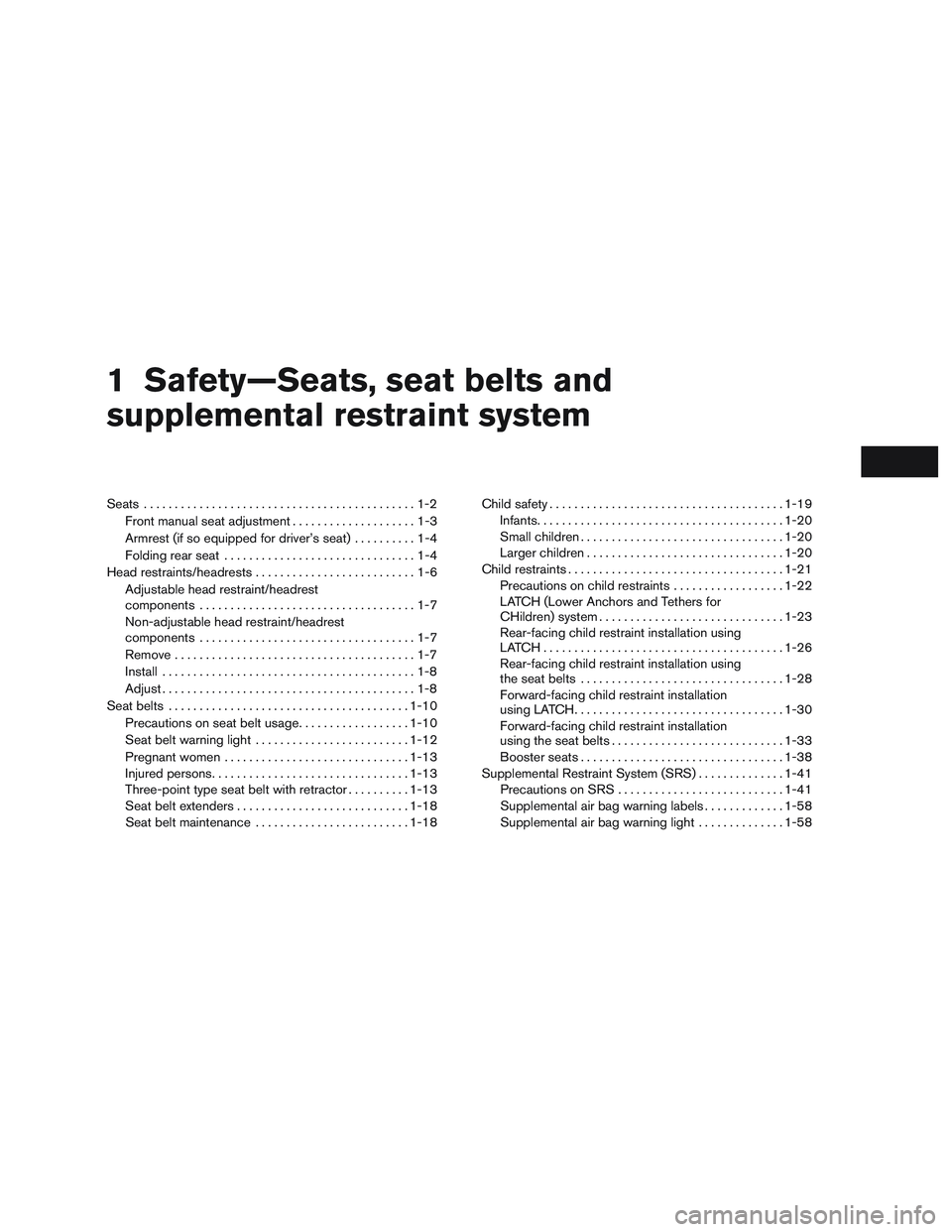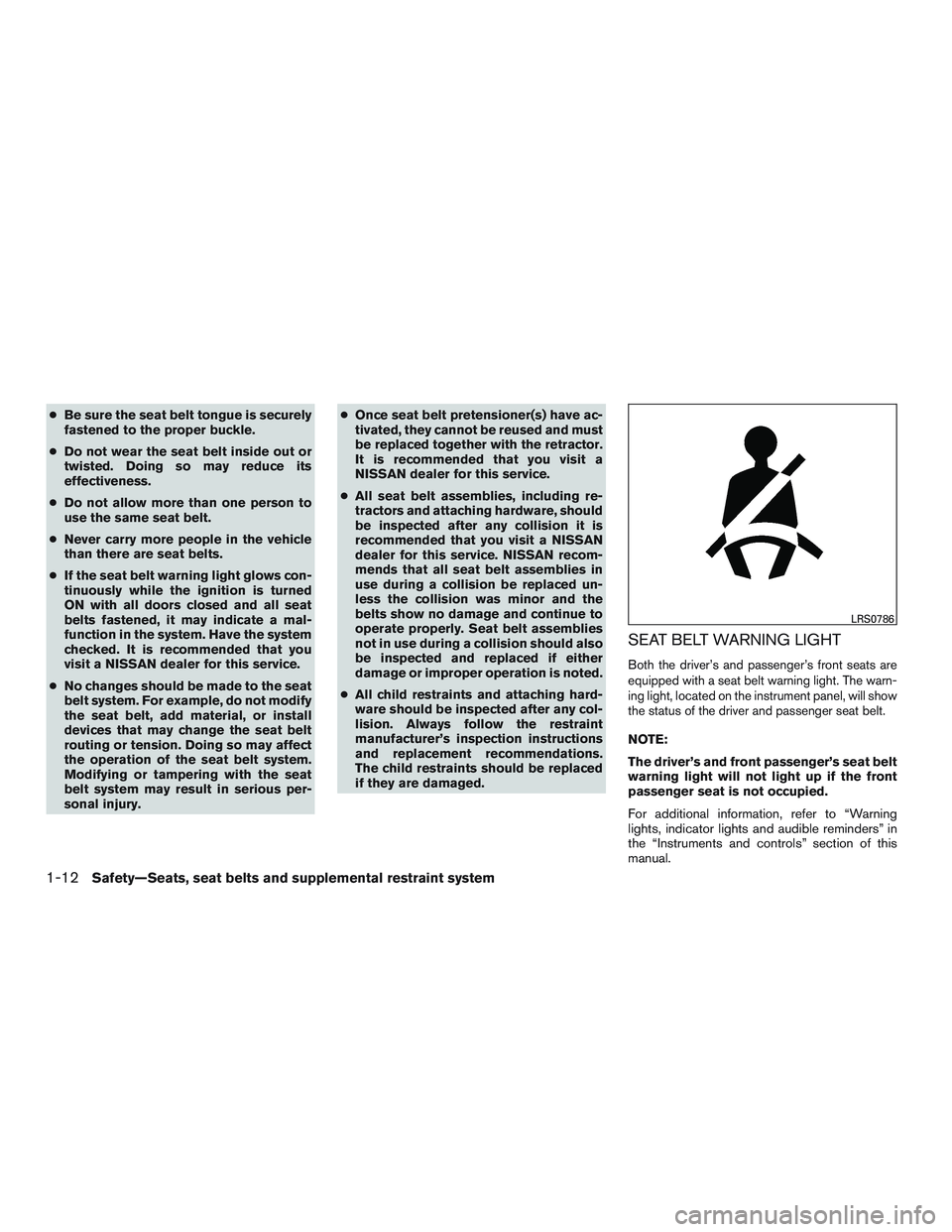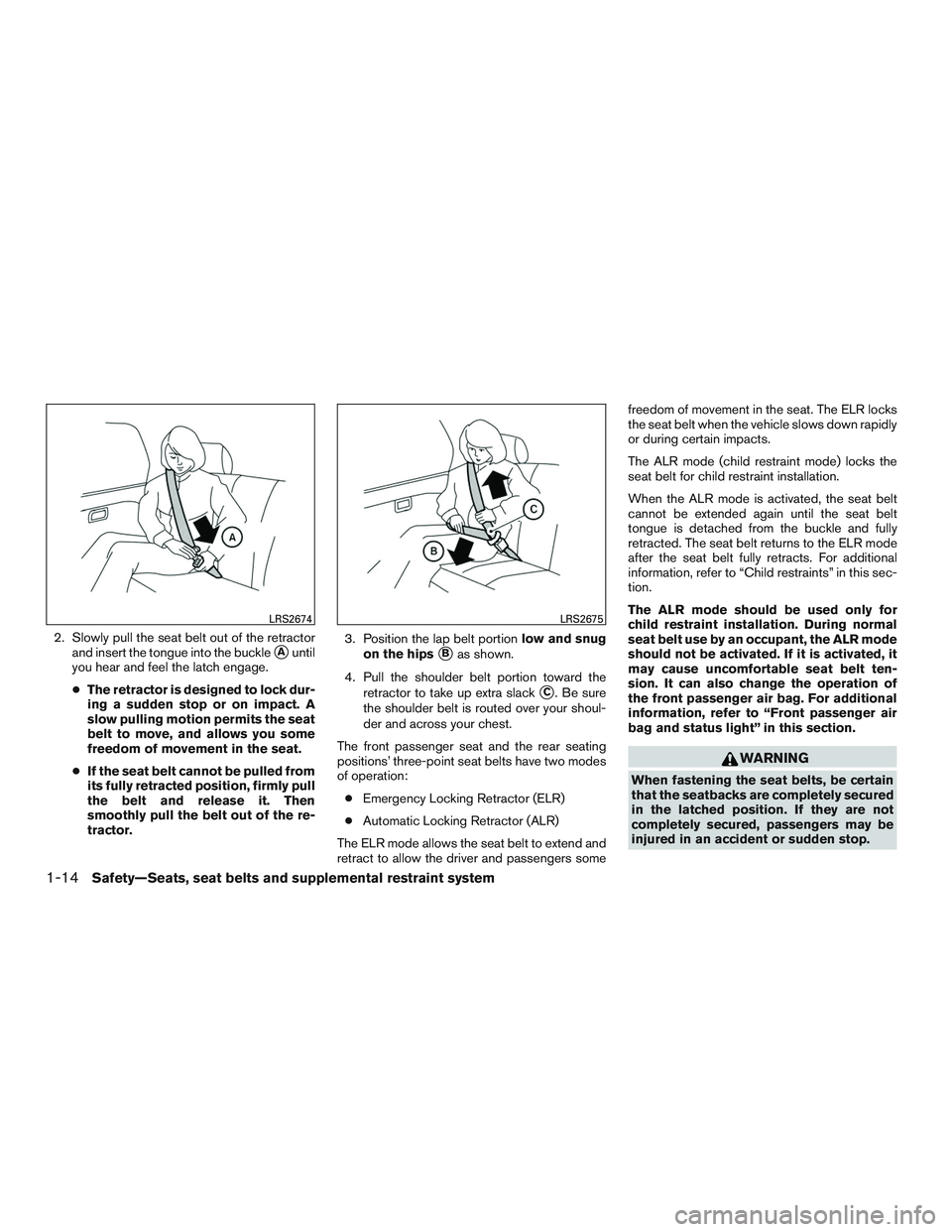Page 8 of 318
0 Illustrated table of contents
Air bags, seat belts and child restraints..............0-2
Exterior front ......................................0-3
Exterior rear .......................................0-4
Passenger compartment ...........................0-5 Instrument panel
...................................0-6
Engine compartment check locations . . ..............0-8
Warning and indicator lights ........................0-9
Page 10 of 318
1. Engine hood (P. 3-8)
2. Windshield (P. 8-15)
3. Wiper and washer switch (P. 2-15)
4. Antenna (P. 4-46)
5. Power windows (if so equipped)(P. 2-26)
6. Door locks (P. 3-3) Key fob (if so equipped) (P. 3-5)
Keys (P. 3-2)
7 Mirrors (P. 3-14)
8. Tire pressure (P. 8-31) Flat tire (P. 6-2)
Tire chains (P. 8-31)
9. Headlight and turn signal switch
(P. 2-17)
Daytime running light system (P. 2-17)
Replacing bulbs (P. 8-21)
10. Fog light switch (if so equipped)
(P. 2-17)
Refer to the page number indicated in pa-
rentheses for operating details.
LII2335
EXTERIOR FRONT
Illustrated table of contents0-3
Page 12 of 318
1. Sun visors (P. 3-12)
2. Interior lights (P. 2-28)
3. Rearview mirror (P. 3-14)
4. Glove box (P. 2-22)
5. Storage trays (P. 2-22)Cup holders (P. 2-22)
Refer to the page number indicated in pa-
rentheses for operating details.
LII2375
PASSENGER COMPARTMENT
Illustrated table of contents0-5
Page 13 of 318
1. Headlight/turn signal switch (P. 2-17)
2. Driver’s supplemental air bag (P. 1-48)Horn (P. 2-20)
3. Meters and gauges (P. 2-3)
4. Wiper and washer switch (P. 2-15)
5. Center vents (P. 4-8)
6. Rear window and outside mirror (if so
equipped) defroster switch (P. 2-17)
7. Hazard warning flasher switch (P. 6-2)
8. Front passenger air bag status light
(P. 1-41)
9. Climate controls (P. 4-8, 4-16)
10. Audio system (P. 4-32, 4-24)
11. Passenger’s supplemental air bag
(P. 1-48)
12. Side vents (P. 4-8)
13. Glove box (P. 2-22)
14. Shift lever (P. 5-8)
15. Cup holders (P. 2-23)
16. 12v power outlet (P. 2-21)
17. USB port (if so equipped) (P. 4-41)
18. Cruise control (if so equipped) (P.5-15)
19. Ignition switch (P. 5-5)
20. Tilt steering (P. 3-12)
LII2367
INSTRUMENT PANEL
0-6Illustrated table of contents
Page 16 of 318

Warninglight Name Page
Anti-lock Braking
System (ABS) warn-
ing light 2-8
Brake warning light 2-8
Charge warning light 2-8
Door open warning
light
2-9
Engine oil pressure
warning light2-9
High temperature
warning light (red)2-9
Low windshield-
washer fluid warning
light2-9
Warning
light Name Page
Power steering
warning light (if so
equipped) 2-9
Seat belt warning
light and chime
2-10
Supplemental air
bag warning light2-10
Indicator
light Name Page
Automatic Transmis-
sion position indica-
tor light (A/T models
only) 2-10
Cruise main switch
indicator light (if so
equipped)
2-11
Front fog light indi-
cator light (if so
equipped)2-11
Indicator
light Name Page
Front passenger air
bag status light 2-11
High beam indicator
light (blue)2-11
Malfunction Indica-
tor Light (MIL)2-11
Overdrive OFF indi-
cator light (A/T
models only)2-12
Security indicator
light (if so equipped)
2-12
Slip indicator light 2-12
Turn signal/hazard
indicator lights2-12
Vehicle Dynamic
Control (VDC) OFF
indicator light2-12
WARNING AND INDICATOR LIGHTS
Illustrated table of contents0-9
Page 18 of 318

1 Safety—Seats, seat belts and
supplemental restraint system
Seats............................................1-2
Front manual seat adjustment . . ..................1-3
Armrest (if so equipped for driver’s seat) ..........1-4
Folding rear seat ...............................1-4
Head restraints/headrests ..........................1-6
Adjustable head restraint/headrest
components ...................................1-7
Non-adjustable head restraint/headrest
components ...................................1-7
Remove .......................................1-7
Install .........................................1-8
Adjust .........................................1-8
Seat belts ....................................... 1-10
Precautions on seat belt usage ..................1-10
Seat belt warning light ......................... 1-12
Pregnant women .............................. 1-13
Injured persons ................................ 1-13
Three-point type seat belt with retractor ..........1-13
Seat belt extenders ............................ 1-18
Seat belt maintenance ......................... 1-18Child safety
...................................... 1-19
Infants ........................................ 1-20
Small children ................................. 1-20
Larger children ................................ 1-20
Child restraints ................................... 1-21
Precautions on child restraints ..................1-22
LATCH (Lower Anchors and Tethers for
CHildren) system .............................. 1-23
Rear-facing child restraint installation using
LATCH....................................... 1-26
Rear-facing child restraint installation using
the seat belts ................................. 1-28
Forward-facing child restraint installation
using LATCH .................................. 1-30
Forward-facing child restraint installation
using the seat belts ............................ 1-33
Booster seats ................................. 1-38
Supplemental Restraint System (SRS) ..............1-41
Precautions on SRS ........................... 1-41
Supplemental air bag warning labels .............1-58
Supplemental air bag warning light ..............1-58
Page 29 of 318

●Be sure the seat belt tongue is securely
fastened to the proper buckle.
● Do not wear the seat belt inside out or
twisted. Doing so may reduce its
effectiveness.
● Do not allow more than one person to
use the same seat belt.
● Never carry more people in the vehicle
than there are seat belts.
● If the seat belt warning light glows con-
tinuously while the ignition is turned
ON with all doors closed and all seat
belts fastened, it may indicate a mal-
function in the system. Have the system
checked. It is recommended that you
visit a NISSAN dealer for this service.
● No changes should be made to the seat
belt system. For example, do not modify
the seat belt, add material, or install
devices that may change the seat belt
routing or tension. Doing so may affect
the operation of the seat belt system.
Modifying or tampering with the seat
belt system may result in serious per-
sonal injury. ●
Once seat belt pretensioner(s) have ac-
tivated, they cannot be reused and must
be replaced together with the retractor.
It is recommended that you visit a
NISSAN dealer for this service.
● All seat belt assemblies, including re-
tractors and attaching hardware, should
be inspected after any collision it is
recommended that you visit a NISSAN
dealer for this service. NISSAN recom-
mends that all seat belt assemblies in
use during a collision be replaced un-
less the collision was minor and the
belts show no damage and continue to
operate properly. Seat belt assemblies
not in use during a collision should also
be inspected and replaced if either
damage or improper operation is noted.
● All child restraints and attaching hard-
ware should be inspected after any col-
lision. Always follow the restraint
manufacturer’s inspection instructions
and replacement recommendations.
The child restraints should be replaced
if they are damaged.
SEAT BELT WARNING LIGHT
Both the driver’s and passenger’s front seats are
equipped with a seat belt warning light. The warn-
ing light, located on the instrument panel, will show
the status of the driver and passenger seat belt.
NOTE:
The driver’s and front passenger’s seat belt
warning light will not light up if the front
passenger seat is not occupied.
For additional information, refer to “Warning
lights, indicator lights and audible reminders” in
the “Instruments and controls” section of this
manual.
LRS0786
1-12Safety—Seats, seat belts and supplemental restraint system
Page 31 of 318

2. Slowly pull the seat belt out of the retractorand insert the tongue into the buckle
�Auntil
you hear and feel the latch engage.
● The retractor is designed to lock dur-
ing a sudden stop or on impact. A
slow pulling motion permits the seat
belt to move, and allows you some
freedom of movement in the seat.
● If the seat belt cannot be pulled from
its fully retracted position, firmly pull
the belt and release it. Then
smoothly pull the belt out of the re-
tractor. 3. Position the lap belt portion
low and snug
on the hips�Bas shown.
4. Pull the shoulder belt portion toward the retractor to take up extra slack
�C. Be sure
the shoulder belt is routed over your shoul-
der and across your chest.
The front passenger seat and the rear seating
positions’ three-point seat belts have two modes
of operation: ● Emergency Locking Retractor (ELR)
● Automatic Locking Retractor (ALR)
The ELR mode allows the seat belt to extend and
retract to allow the driver and passengers some freedom of movement in the seat. The ELR locks
the seat belt when the vehicle slows down rapidly
or during certain impacts.
The ALR mode (child restraint mode) locks the
seat belt for child restraint installation.
When the ALR mode is activated, the seat belt
cannot be extended again until the seat belt
tongue is detached from the buckle and fully
retracted. The seat belt returns to the ELR mode
after the seat belt fully retracts. For additional
information, refer to “Child restraints” in this sec-
tion.
The ALR mode should be used only for
child restraint installation. During normal
seat belt use by an occupant, the ALR mode
should not be activated. If it is activated, it
may cause uncomfortable seat belt ten-
sion. It can also change the operation of
the front passenger air bag. For additional
information, refer to “Front passenger air
bag and status light” in this section.
WARNING
When fastening the seat belts, be certain
that the seatbacks are completely secured
in the latched position. If they are not
completely secured, passengers may be
injured in an accident or sudden stop.
LRS2674LRS2675
1-14Safety—Seats, seat belts and supplemental restraint system